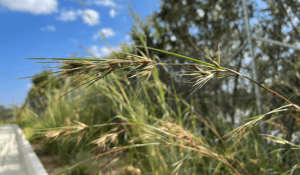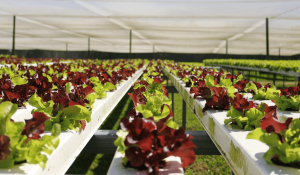Tucked away in the depths of a snowy mountain in Svalbard lies a vault that holds the key to our future food systems. The remote fortress holds millions of seeds from across the world.
More than 930,000 varieties of food crops are held in the Global Seed Vault (Duggan, 2023). Think of it like a huge safety deposit box only instead of money; it holds the world’s largest collection of agricultural biodiversity.
Similarly to a safety deposit box, countries can deposit seeds into the vault and are the only ones with the authority to take them out. The Seed Vault has been nicknamed the “doomsday vault”, which gives the impression that its purpose is to safeguard food against an apocalypse or global catastrophe. However, it’s the smaller-scale destruction, such as extreme weather events, pests, disease, war, and terror, that we need a backup plan for.
Why Is The Seed Vault Necessary?

Losing a crop variety is the same as the extinction of a dinosaur or any other animal/lifeform. They are simply irreversible. Since the 1900s, the U.S. has lost more than 90% of its fruit and vegetable varieties resulting in a monoculture nature of agriculture, leaving our food supplies vulnerable (Duggan, 2023).
Over 20 years, Australia’s threatened plant, tree, shrub, herb and orchid population declined by 72% (Tulloch et al., 2020). Land clearing, changed fire regimes, grazing by livestock and feral animals, diseases, weeds, natural disasters, and climate change are common causes of species decline (Tulloch et al., 2020).
Dr Cary Fowler is commonly referred to as the ‘father’ of the Svalbard Seed Vault, and in a Ted Talk, he stated that while we may not look at a carrot seed the same way we look at a panda, we still must protect them the same. His book ‘Seeds on Ice: Svalbard and the Global Seed Vault‘ is an incredible read if you would like to hear more from him.
How It Works

As mentioned, the Global Seed Vault works in much the same way as a safety deposit box does. The seeds remain the property of the country that deposited them and can be withdrawn by only them if their stockpile is compromised. The deep-freeze facility is designed to last forever and is co-managed by the Norwegian government, The Crop Trust and NordGen (Greenfield, 2023).
Entry is exclusive, and only a handful of people are granted access. The five metal doors are only opened a few times each year purely to deposit new seeds (Nowakowski, 2023).
According to Nowakowski, 2023, the Arctic Vault is protected by almost 400 feet of rock at its deepest point. The seed vault is burrowed over 100 metres into the mountain, and the room is divided into three chambers, all with extensive shelving to store a maximum of 2.5 billion seeds inside (Crop Trust, 2023). The seeds are sealed in custom-made three-ply foil packages that are stored in boxes on the shelves in these rooms (Crop Trust, 2023).
The seeds are stored at an optimal temperature of −18°C, and the thick rock and permafrost ensure the seed samples remain frozen even without power (Crop Trust, 2023). Additionally, natural freezing also helps to save on energy and costs. The low temperature, moisture and humidity levels inside the vault ensure low metabolic activity to preserve the seeds for long periods of time (Crop Trust, 2023).
What’s In The Global Seed Vault Now?
This icy fortress of hope holds the world’s most diverse collection of food crop seeds. Over 1 million seeds reside in the vault (Crop Trust, 2023). Almost every country in the world has deposited their seeds in the vault. The varieties range from major African and Asian staples such as wheat, maize, rice, and sorghum to European and South American varieties of eggplant, lettuce and potato (Crop Trust, 2023).
Isn’t it crazy to think that nearly every country in the world has come together in order to achieve a common goal? The former lead partnerships coordinator of the Crop Trust, Brian Lainoff, put it perfectly. He stated, “The seeds don’t care that North Korean and South Korean seeds are in the same aisle. They’re cold and safe up there, and that’s all that matters” (Nowakowski, 2023).
Australia made its first deposit back in 2011. Dr Tony Gregson, a Victorian farmer, accompanied the boxes to Svalbard and said, “Australian farmers have recently had to deal with droughts and floods. This is terribly difficult for farming communities and also affects food prices worldwide. Harsh reminders of the need to find crop varieties that will help adapt to these changing conditions” (Australian Grains Genebank, 2023).
If you follow the awesome Virtual Tour, you will see the box Australia last delivered back in 2018 containing 278 seed samples of Chickpeas. How cool! The Australian Genebank has 42 boxes in the Seed Vault, ranking it seventh among national depositors (Australian Grains Genebank, 2023).
Sowing The Seeds Of Possibility
In a world where climate change and environmental threats are looming over our heads, the Global Seed Vault stands as a beacon of hope for our future food system. Each seed has a purpose in safeguarding Earth’s biodiversity.
The Seed Vault’s vast collection of diverse plant genetic resources serves invaluable for businesses such as Green Endeavour. It ensures the availability of crop varieties to ensure the sustainability and success of farming endeavours for years to come.
References:
Australian Grains Genebank. (2023, March 31). About the Australian Grains Genebank. Agriculture Victoria. https://agriculture.vic.gov.au/crops-and-horticulture/the-australian-grains-genebank/about-the-australian-grains-genebank
Crop Trust. (2023). Svalbard Global Seed Vault. Crop Trust – Securing our food, forever. https://www.croptrust.org/work/svalbard-global-seed-vault/
Duggan, J. (2023). INSIDE THE ‘DOOMSDAY’ VAULT. Time. https://time.com/doomsday-vault/
Greenfield, P. (2023, March 3). Svalbard’s mysterious ‘doomsday’ seed vault offers glimpse inside with virtual tour. The Guardian. https://www.theguardian.com/environment/2023/mar/03/global-seed-vault-svalbard-virtual-tour-aoe
Nowakowski, T. (2023, March 16). Take a Virtual Tour of the ‘Doomsday’ Seed Vault. Smithsonian.com. https://www.smithsonianmag.com/smart-news/take-a-virtual-tour-of-the-doomsday-seed-vault-180981815/
TED Conferences. (2009). Tedtalks: Cary Fowler–one seed at a time, protecting the future of food. One seed at a time, protecting the future of food. Retrieved from https://www.ted.com/talks/cary_fowler_one_seed_at_a_time_protecting_the_future_of_food
Tulloch, A., Bayraktarov, E., Possingham, H., Dielenberg, J., Silcock, J., Jackson, M. V., & Butt, N. (2020, December 16). Australia-first research reveals staggering loss of threatened plants over 20 years. The Conversation. https://theconversation.com/australia-first-research-reveals-staggering-loss-of-threatened-plants-over-20-years-151408



